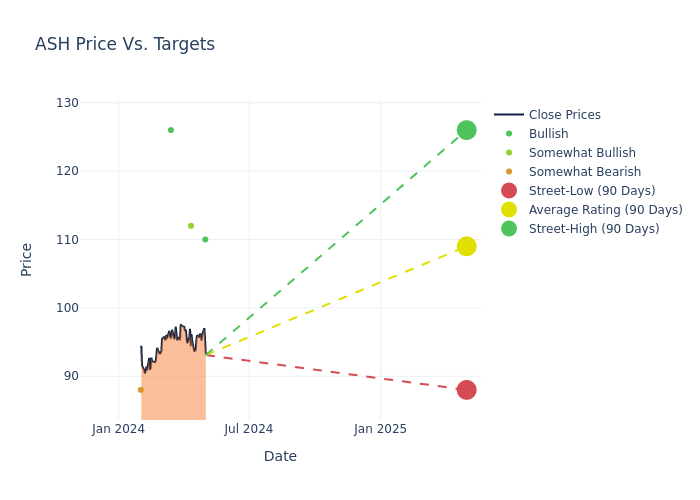3 analysts have expressed a variety of opinions on Ashland (NYSE:ASH) over the past quarter, offering a diverse set of opinions from bullish to bearish.
The table below provides a concise overview of recent ratings by analysts, offering insights into the changing sentiments over the past 30 days and drawing comparisons with the preceding months for a holistic perspective.
| Bullish | Somewhat Bullish | Indifferent | Somewhat Bearish | Bearish | |
|---|---|---|---|---|---|
| Total Ratings | 2 | 1 | 0 | 0 | 0 |
| Last 30D | 1 | 0 | 0 | 0 | 0 |
| 1M Ago | 0 | 1 | 0 | 0 | 0 |
| 2M Ago | 1 | 0 | 0 | 0 | 0 |
| 3M Ago | 0 | 0 | 0 | 0 | 0 |
Analysts provide deeper insights through their assessments of 12-month price targets, revealing an average target of $116.0, a high estimate of $126.00, and a low estimate of $110.00. This upward trend is evident, with the current average reflecting a 15.62% increase from the previous average price target of $100.33.

Diving into Analyst Ratings: An In-Depth Exploration
An in-depth analysis of recent analyst actions unveils how financial experts perceive Ashland. The following summary outlines key analysts, their recent evaluations, and adjustments to ratings and price targets.
| Analyst | Analyst Firm | Action Taken | Rating | Current Price Target | Prior Price Target |
|---|---|---|---|---|---|
| John Roberts | Mizuho | Raises | Buy | $110.00 | $101.00 |
| Michael Sison | Wells Fargo | Raises | Overweight | $112.00 | $100.00 |
| Laurence Alexander | Jefferies | Raises | Buy | $126.00 | $100.00 |
Key Insights:
- Action Taken: In response to dynamic market conditions and company performance, analysts update their recommendations. Whether they 'Maintain', 'Raise', or 'Lower' their stance, it signifies their reaction to recent developments related to Ashland. This insight gives a snapshot of analysts' perspectives on the current state of the company.
- Rating: Analysts assign qualitative assessments to stocks, ranging from 'Outperform' to 'Underperform'. These ratings convey the analysts' expectations for the relative performance of Ashland compared to the broader market.
- Price Targets: Analysts set price targets as an estimate of a stock's future value. Comparing the current and prior price targets provides insight into how analysts' expectations have changed over time. This information can be valuable for investors seeking to understand consensus views on the stock's potential future performance.
Capture valuable insights into Ashland's market standing by understanding these analyst evaluations alongside pertinent financial indicators. Stay informed and make strategic decisions with our Ratings Table.
Stay up to date on Ashland analyst ratings.
Unveiling the Story Behind Ashland
Ashland Inc is a world-wide specialty materials company that serves a wide range of industrial markets. The company has a business-centric operating model and is organized into four distinct segments: life sciences, personal care, specialty additives, and intermediates. Key customers for the firm include pharmaceutical companies and manufacturers of personal care products, food and beverages, and nutraceuticals and supplements. The life sciences segment derives maximum revenue. Ashland includes only U.S. and Canada in its North America designation and includes Europe, the Middle East and Africa in its Europe designation.
Unraveling the Financial Story of Ashland
Market Capitalization: Indicating a reduced size compared to industry averages, the company's market capitalization poses unique challenges.
Decline in Revenue: Over the 3 months period, Ashland faced challenges, resulting in a decline of approximately -9.9% in revenue growth as of 31 December, 2023. This signifies a reduction in the company's top-line earnings. When compared to others in the Materials sector, the company faces challenges, achieving a growth rate lower than the average among peers.
Net Margin: Ashland's financial strength is reflected in its exceptional net margin, which exceeds industry averages. With a remarkable net margin of 5.5%, the company showcases strong profitability and effective cost management.
Return on Equity (ROE): Ashland's ROE is below industry standards, pointing towards difficulties in efficiently utilizing equity capital. With an ROE of 0.85%, the company may encounter challenges in delivering satisfactory returns for shareholders.
Return on Assets (ROA): Ashland's ROA stands out, surpassing industry averages. With an impressive ROA of 0.44%, the company demonstrates effective utilization of assets and strong financial performance.
Debt Management: Ashland's debt-to-equity ratio is below the industry average at 0.48, reflecting a lower dependency on debt financing and a more conservative financial approach.
Analyst Ratings: Simplified
Ratings come from analysts, or specialists within banking and financial systems that report for specific stocks or defined sectors (typically once per quarter for each stock). Analysts usually derive their information from company conference calls and meetings, financial statements, and conversations with important insiders to reach their decisions.
Some analysts publish their predictions for metrics such as growth estimates, earnings, and revenue to provide additional guidance with their ratings. When using analyst ratings, it is important to keep in mind that stock and sector analysts are also human and are only offering their opinions to investors.
This article was generated by Benzinga's automated content engine and reviewed by an editor.
